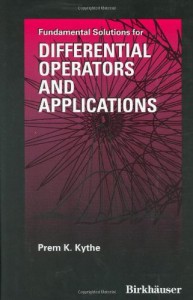The main purpose of this book is to provide a self-contained and systematic development of an aspect of analysis which deals with the theory of fundamental solutions for differential operators and their applications to boundary value problems of mathematical physics, applied mathematics, and engineering, with the related computational aspects. A variety of classical application topics are presented in physics, quantum mechanics, elasticity and fluid dynamics. Additional applications included maximum principle, Cauchy problem, heat and wave potentials, wave propagation, anisotropy, porous media, piezocrystal waves, plate bending, and boundary element methods. The application of fundamental solutions to a recently developed area of boundary element methods has provided a distinct advantage in that an integral equation representation of a boundary value problem is often more easily solved by numerical methods than a differential equation with specified boundary/initial conditions. This situation makes the subject more attractive to those whose interest is primarily in numerical methods. Recent advances in the area of boundary element methods, where the theory of fundamental solutions plays a pivotal role, has provided a prominent place in research in partial differential equations and related boundary value problems. Computational components receive special attention throughout the book. The book offers an accessible and up-to-date survey for advanced students and practitioners in applied mathematics, mechanical engineering and the physical sciences. Features: Extensive applications topics presented in detail, with numerous worked examples Coverage of over 70 different differential operators and their fundamental solutions Computational components discussed in all relevant topics and applications Appendix B describes numerous algorithms, programs in C++ and Mathematica programs to illustrate solutions methods Contents: Preface Notation Introduction 1. Historical Background 2. Modern Developments Chapter 1: Some Basic Concepts 1.1 Definitions 1.2 Green's Identities 1.3 Distributions 1.4 Fundamental Solutions Chapter 2: Linear Elliptic Operators 2.1 Constant Coefficients 2.2 Laplace Operator 2.3 Helmholtz Operator 2.4 Cauchy-Riemann Operator 2.5 Nonhomogeneous Operator 2.6 Maximum Principle 2.7 Method of Images Chapter 3: Linear Parabolic Operators 3.1 Diffusion Operator 3.2 Heat Potentials 3.3 Cauchy Problem 3.4 Maximum Principle 3.5 Schrodinger Operator 3.6 Method of Images Chapter 4: Linear Hyperbolic Operators 4.1 Wave Operator 4.2 Harmonic Oscillators 4.3 Wave Potentials 4.4 Cauchy Problem 4.5 Wave Propogation 4.6 Maxwell's Equations Chapter 5: Nonlinear Operators 5.1 Einstein-Kolmogorov Operator 5.2 Fokker-Plank Operator 5.3 Klein-Gordon Operator 5.4 Dirac's Operator 5.5 Transport Equation 5.6 Transport Operator 5.7 Bilharmonic Operator 5.8 Nonlinear Wave Equations 5.9 The triangle-function 5.10 Quasihyperbolic Operator Chapter 6: Elastostatics 6.1 Basic Relations 6.2 Cauchy-Navier Operator 6.3 Half-Space Solutions 6.4 Axisymmetric Solutions 6.5 Somigliana's Identity Chapter 7: Elastodynamics 7.1 Elastodynamic Operator 7.2 Wave Structures 7.3 Bernoulli-Euler Operator 7.4 Elastoplasticity 7.5 Anisotropic Medium Chapter 8: Fluid Dynamics 8.1 Navier-Stokes Equations 8.2 Aerodynamic Flows 8.3 Non-Newtonian Flows 8.4 Porous Media 8.5 Underwater Acoustic Scattering Chapter 9: Piezoelectrics 9.1 Green's Functions 9.2 Dynamic Piezoelectric Operator 9.3 Fundamental Solutions 9.4 Steady-State Solutions 9.5 Piezocrystal Waves Chapter 10: Boundary Element Methods 10.1 Boundary Integral Equations 10.2 Boundary Element Method 10.3 Poisson Equation 10.4 Transient Fourier Equation 10.5 Laplace Transform BEM 10.6 Elastostatic BEM 10.7 Fracture Mechanics Chapter 11: Domain Integrals 11.1 Dual Reciprocity Method 11.2 Multiple Reciprocity Method 11.3 Transient DRM 11.4 Transient MRM 11.5 Fourier Series Method 11.6 Complex Variable BEM Chapter 12: Finite Deflection Plates 12.1 von Karman Equations 12.2 Boundary Integral Equations 12.3 Large Deflections 12.4 Singularities in Biharmonic Problems Chapter 13: Miscellaneous Topics 13.1 Poroelasticity 13.2 Heat Condition 13.3 Thermoelastcity 13.4 Neutron Diffusion 13.5 Biomechanics Chapter 14: Quasilinear Elliptic Operator 14.1 p -Laplacian 14.2 Lane-Emden Equation 14.3 Emden-Fowler Equation 14.4 Black Hole Solutions 14.5 Einstein-Yang-Mills Equation Appendix A : Transform of Distributions A.1 Fourier Transform A.2 Laplace Transform A.3 Inverse Laplace Transform Appendix B: Computational Aspects Appendix C: List of Differential Operators Bibliography Index
Fundamental solutions for differential operators a
Sobre
Talvez você seja redirecionado para outro site












